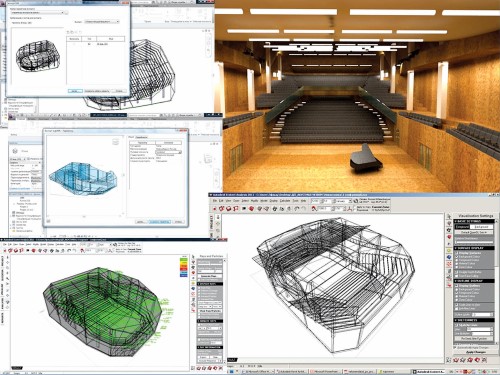
Acoustics in contemporary theatre and concert halls uses scientific approach
Such assertions can be considered disputable only partially. Actually, the world boasts many old theatres with fine acoustics. However, many ‘temples of the art’, built in the same remote times, unfortunately lack this advantage. The paradox is that contemporary audience halls are sometimes truly built with disgusting quality of natural sound, despite our knowledge having progressed greatly since the days of Ancient Greece or the flowering of theatrical art in the 18th century.
In search of the answer, I visited Institute BelNIIS enterprise’s Laboratory of Building Acoustics and Vibrating Safety, where acoustic calculations are made for all major halls being restored or under construction in the country. The head of the laboratory Yuri Muzychkin tells us, “Natural acoustics in concert halls and theatres can leave much to be desired, but we cannot blame science. Before carrying out reconstruction, we receive orders for acoustic calculations, which we carry out, making recommendations for particular elements of the hall, including preferred materials. However, the fulfilment of these recommendations depends on the work of whoever wins the tender. Sadly, decisions are often based on price rather than quality. Moreover, it’s not obligatory that the authors of the project would listen to science. For the reconstruction of the National Academic Bolshoi Opera and Ballet Theatre, we prepared 11 recommendations, but only a few were applied. After reconstruction, we found that the natural acoustics had not been spoilt but nor had they been improved, as would have been possible. Of course, we aren’t allowed to change the geometry of a hall, since original buildings have architectural integrity, but it is possible to change the internal shape slightly in some cases for the sake of acoustics improvement.”
Gaining knowledge of natural acoustics, even with the help of magnificent computer programmes and precision measuring equipment, is expensive and time-consuming. Some restorers in the neighbouring countries try to save time and money and haven’t conducted such research in recent times; they simply rely on electroacoustic systems. Of course, BelNIIS experts are not always invited not share their expertise: such is the case at the Yanka Kupala Theatre. Mr. Muzychkin notes that, before reconstruction, it boasted the best acoustics in the country. Despite an acoustic assessment having been made by BelNIIS, the organisation has not been asked to become further involved.
Certainly, no hall can be perfect: ‘dead zones’ are inevitable. A BelNIIS ‘acoustic map’ of the Belarusian State Circus shows that some seating areas lack good audibility. Sitting near the front is not necessarily the answer, as various sections of the stalls suffer, regardless of distance. When the circus was first built, computer modelling did not exist: only reverberation could be measured (a late 19th century innovation which correlates geometrical parameters and the number of seats). These days, such data is used to help align the density of sound.
Similar mathematical exercises were incredibly complex in the days before computer technologies: as a result, most of the world’s theatre and concert halls lack perfect acoustics — even the Sydney Opera House! Constructed in 1973 and recognised as a monument of the UNESCO World Heritage List, it is sadly lacking from an acoustic view.
In fact, most Belarusian venues have reasonably good acoustic properties. Improvements are always possible, although the restrictions of restoration and reconstruction of ‘vintage’ halls hamper innovation. However, new construction offers the chance to optimise the quality of sound: as at the National Library, the summer amphitheatre of the Slavianski Bazaar in Vitebsk, and the sports complexes of Minsk-Arena and Chizhovka-Arena. In planning our public buildings, acoustics should be as essential to the design as aesthetic beauty and functionality.
By Dmitry Patyko











